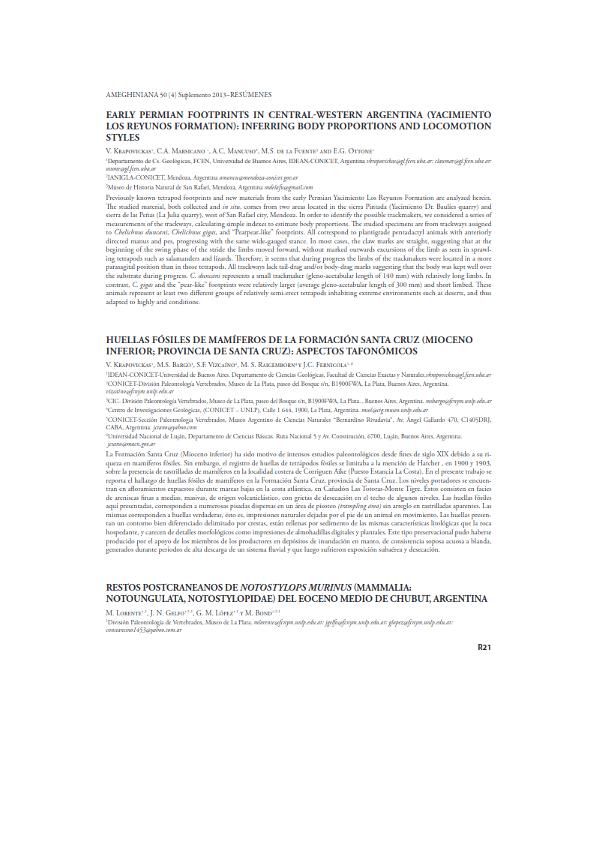Evento
Early Permian footprints of central-western Argentina (Yacimiento Los Reyunos Formation): inferring body proportions and locomotion styles.
Krapovickas, Verónica ; Marsicano, Claudia Alicia
; Marsicano, Claudia Alicia ; Mancuso, Adriana Cecilia
; Mancuso, Adriana Cecilia ; de la Fuente, Marcelo Saul
; de la Fuente, Marcelo Saul ; Ottone, Eduardo Guillermo
; Ottone, Eduardo Guillermo
 ; Marsicano, Claudia Alicia
; Marsicano, Claudia Alicia ; Mancuso, Adriana Cecilia
; Mancuso, Adriana Cecilia ; de la Fuente, Marcelo Saul
; de la Fuente, Marcelo Saul ; Ottone, Eduardo Guillermo
; Ottone, Eduardo Guillermo
Tipo del evento:
Jornada
Nombre del evento:
XXVII Jornadas Argentinas de Paleontología de Vertebrados
Fecha del evento:
22/05/2013
Institución Organizadora:
Universidad Nacional de La Rioja;
Asociación Paleontológica Argentina;
Título de la revista:
Ameghiniana
Editorial:
Asociación Paleontológica Argentina
Idioma:
Español
Clasificación temática:
Resumen
Previously known tetrapod footprints and new materials from the Cisuralian Yacimiento Los Reyunos Formation are analyzed herein. The studied material, both collected and in situ, comes from two areas located in the sierra Pintada (Yacimiento Dr. Baulíes quarry) and sierra de las Peñas (La Julia quarry), west of San Rafael city, Mendoza. In order to identify the possible trackmakers we considered a series of measurements to estimate body proportions from the trackwaysand developed simple indexes. The studied specimens correspond to trackways assigned to Chelichnusduncani, Chelichnus gigas and "Pear-like" footprints. All correspond to plantigrade pentadactyl animals with manus and pesanteriorly directed, progressing with the same wide-gauged stance. In most cases, the claw marks are straight suggesting that at the beginning of the swing phase of the stride the limbs moved forward, without marked excursions of the limb outwards as seen in sprawling tetrapods as salamanders and lizards. Therefore, it seems that during progression the limbs of the trackmakers were located in a more parasagital position than in those tetrapods. All trackways lack tail drag and/or body drag marks suggesting that the body was kept well over the substrate during progression. C. duncani represents a small trackmaker (gleno-acetabular length of 140 mm) with relatively long limbs. In contrast, C.gigas and the "pear-like" footprints were relatively larger (average gleno-acetabular length of 300 mm) and short limbed. These animals represent at least two different groups of relatively semi-erect tetrapods that were inhabitants of an extreme environment as deserts and thus adapted to high degree of aridity conditions.
Palabras clave:
TETRAPODS
,
FOOTPRINTS
,
PERMIAN
,
MENDOZA
Archivos asociados
Licencia
Identificadores
Colecciones
Eventos(IANIGLA)
Eventos de INST. ARG. DE NIVOLOGIA, GLACIOLOGIA Y CS. AMBIENT
Eventos de INST. ARG. DE NIVOLOGIA, GLACIOLOGIA Y CS. AMBIENT
Eventos(IDEAN)
Eventos de INSTITUTO DE ESTUDIOS ANDINOS "DON PABLO GROEBER"
Eventos de INSTITUTO DE ESTUDIOS ANDINOS "DON PABLO GROEBER"
Citación
Early Permian footprints of central-western Argentina (Yacimiento Los Reyunos Formation): inferring body proportions and locomotion styles.; XXVII Jornadas Argentinas de Paleontología de Vertebrados; La Rioja; Argentina; 2013; 21-21
Compartir



